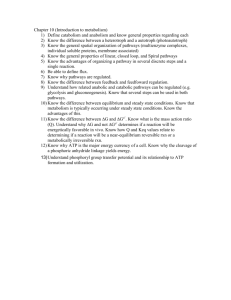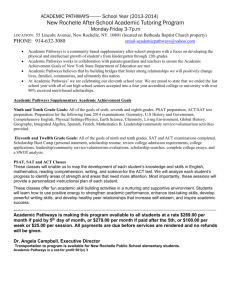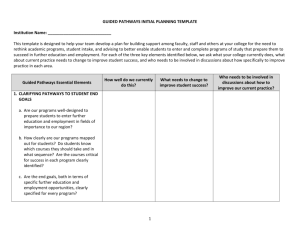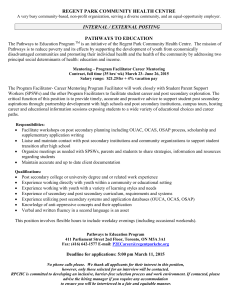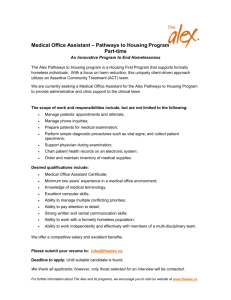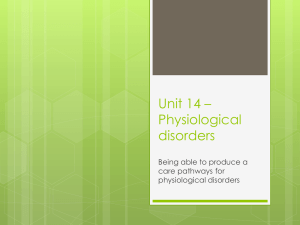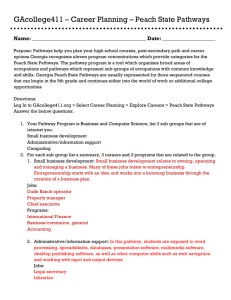Pathways to Transfer + Mt. SAC = Student Success
advertisement
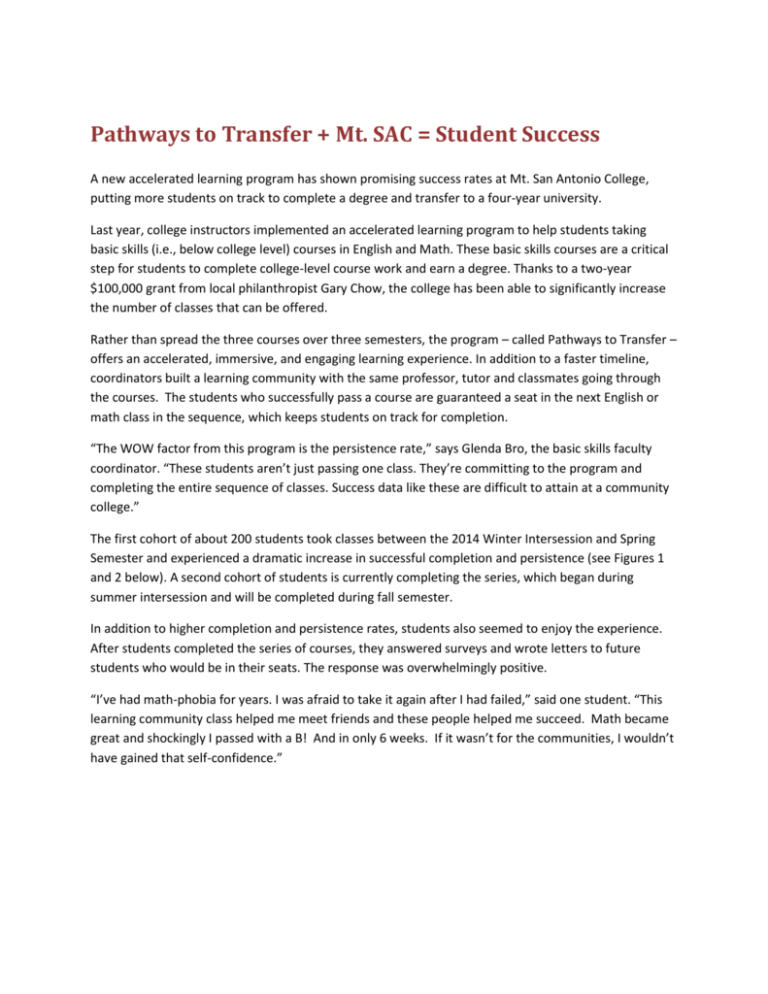
Pathways to Transfer + Mt. SAC = Student Success A new accelerated learning program has shown promising success rates at Mt. San Antonio College, putting more students on track to complete a degree and transfer to a four-year university. Last year, college instructors implemented an accelerated learning program to help students taking basic skills (i.e., below college level) courses in English and Math. These basic skills courses are a critical step for students to complete college-level course work and earn a degree. Thanks to a two-year $100,000 grant from local philanthropist Gary Chow, the college has been able to significantly increase the number of classes that can be offered. Rather than spread the three courses over three semesters, the program – called Pathways to Transfer – offers an accelerated, immersive, and engaging learning experience. In addition to a faster timeline, coordinators built a learning community with the same professor, tutor and classmates going through the courses. The students who successfully pass a course are guaranteed a seat in the next English or math class in the sequence, which keeps students on track for completion. “The WOW factor from this program is the persistence rate,” says Glenda Bro, the basic skills faculty coordinator. “These students aren’t just passing one class. They’re committing to the program and completing the entire sequence of classes. Success data like these are difficult to attain at a community college.” The first cohort of about 200 students took classes between the 2014 Winter Intersession and Spring Semester and experienced a dramatic increase in successful completion and persistence (see Figures 1 and 2 below). A second cohort of students is currently completing the series, which began during summer intersession and will be completed during fall semester. In addition to higher completion and persistence rates, students also seemed to enjoy the experience. After students completed the series of courses, they answered surveys and wrote letters to future students who would be in their seats. The response was overwhelmingly positive. “I’ve had math-phobia for years. I was afraid to take it again after I had failed,” said one student. “This learning community class helped me meet friends and these people helped me succeed. Math became great and shockingly I passed with a B! And in only 6 weeks. If it wasn’t for the communities, I wouldn’t have gained that self-confidence.” Success Rate of Non-Pathways and Pathways Students Non-Pathways Pathways 74.7% 71.2% 64.5% 47.3% Basic Skills Math Basic Skills English Figure 1 This chart shows the overall success rate of non-Pathways and Pathways students over two semesters. Pathways students were more likely to successfully pass their class. Math students in the Pathways program (n=360) passed at 74.7% compared to the non-Pathways students (n=2,855), who passed at 47.3%. In English, Pathway students (n=229) experienced a 71.2% pass rate compared to 64.5% for non-Pathways students (n=4,899). Persistence Over Two Courses of Non-Pathways and Pathways Students Non-Pathways Pathways 56.2% 55.4% 28.3% 20.0% Basic Skills Math Basic Skills English Figure 2 This chart shows the number of non-Pathways students and Pathways students who successfully completed two courses in sequence within two semesters. Winter 2014 Pathways students continued in their basic skills courses at about twice the rate of non-Pathways cohort students. Math students in the Pathways program (n=121) completed their sequence of courses at 56.2% compared to 20% of their non-Pathways peers (n=225). In English basic skills courses, 55.4% of students in the Pathways program (n=83) completed their sequence of courses compared to 28.3% of their peers (n=389). Pathways to Transfer The Pathways to Transfer program incorporates the latest research in teaching and learning. The accelerated learning program has the potential to increase learning for students, while also increasing the percentage of students who complete the basic skills sequence of math and English. The program incorporates the following accelerated learning techniques: “The Pathways program has not only given me the opportunity to get a series of classes that I need, but it’s given me the opportunity to connect with fellow students and make friends. We’ve all become great friends, which has caused us to care about each other encouraging each other to study and strive for the best when it comes to our education.” – Student Testimonial A Condensed Timeframe – Students in the program are immersed in the subject. By fitting three courses over an intersession and semester, these students are fully engaged in the subject. Supportive Programs – The program provides a tutor who is a part of the class. In addition, the classes are linked to learning community, counseling, and library classes, where the professor teaches important skills for students to be successful. A Positive Learning Environment – Students go through the three courses together, with the same professor and tutor. The continuity helps build a supportive, engaging learning community. Class projects also encourage active participation and collaboration. Pathways to Transfer is structured to align with models of student learning, such as High Impact Practices of the Association of American Colleges and Universities (AAC&U) as well as the indicators of strong student engagement and excellent institutional practices as measured by the Community College Survey of Student Engagement (CCSSE).
